In Japanese, a circle (○ or ◯), maru 丸, has multiple uses: it typically means something is "correct," that an answer is "right." In this case, "wrong" is either an X mark or a check mark (✓), and a triangle (△) is half-right. It's also used as a placeholder, specially to censor words. And it may be used instead of the digit zero, 0.
This article is about the circle symbol, not about a "circle," saakuru サークル, in the sense of a group of people that do an activity like drawing doujinshi 同人誌.
Anime: Himouto! Umaru-chan 干物妹!うまるちゃん (Episode 1)
Anime: Nichijou no Zero-wa 日常の0話 (Episode 0, OVA)
Correct
The circle may mean an answer is "correct," or is the correct one. In this case, the X marks the wrong answer.
- Context: someone gets a yojijukugo 四字熟語, "four character idiom," wrong.
- saishoku-kenbi
才色兼備
(For a woman) to have both wit and beauty.- Correct, marked by the circle: saishoku 才色, from saichi 才知, "wit," and iro 色, "color."
- Incorrect, marked by the X: saishoku 才食, with shoku 食 meaning "to have meal," or "to eat," taberu 食べる.
- In this episode, a character who often uses four character idioms wrong makes this mistake when complimenting a girl for eating a lot of food.
Exceptionally, in grading school exams, a check mark is used for the wrong answers, while a circle is used for right answers.
Anime: Himouto! Umaru-chan 干物妹!うまるちゃん (Episode 1)
Anime: Nichijou no Zero-wa 日常の0話 (Episode 0, OVA)
- Context: the more circles in a graded test, the better the score.
Double Circle
A "double circle" (◎), ni-juu maru 二重丸, is sometimes used to symbolize a grade above the normal circle.
- In a student's report card, which may include things like behavior, a circle could indicate they're a good student, while a double circle indicates they're a perfect student.
Gesture
Making a circle with your arms by touching fingers over your head is a gesture that can mean approval or confirmation.
Anime: Zombieland Saga: Revenge (Episode 7)
Making a circle with just your index and thumb like an OK sign is a completely different thing.
Anime: Nisemonogatari 偽物語 (Episode 1)
- Context: a money hand sign, which has basically nothing to do with this article.
Placeholder
The circle, X, and triangle can be used as placeholders or to censor text, used in this order. For example: "thing X, thing Y, thing Z" would become "thing 〇, thing ×, thing △." For single-character placeholders, a single symbol is used. Variable-length words often use two of them instead, e.g.:
- maru-maru-san to batsu-batsu-san
〇〇さんと××さん.
Mr. X and Mr. Y.
- ~san ~さん - a honorific suffix, used after a person's name.
- Context: two characters try to make plans.
- One suggests a certain date (month X, day Y).
- maru-gatsu batsu-hi
○月×日
Month circle, day X. (literally.) - See also: Japanese date format.
- maru-gatsu batsu-hi
- The other gestures an X, meaning that date is "not good" for her, dame 駄目.
Sometimes, a solid circle (●) is used as placeholder instead of the hollow one. There's no difference between them.
The circles can also be read as nanika なにか, "something." They're particularly used to show how affixes work. Sometimes, a tilde (~), read as nan'yara なんやら, is used as placeholder instead.
- o__san
お〇〇さん (or お~さん)
A pattern found in several words, like omawarisan お巡りさん, "patrolling police officer," oneesan お姉さん, "older sister," okyakusan お客さん, "client," "customer," among others. - __kei
〇〇系
A __ type, e.g. nichijou-kei 日常系, "daily life type," is a term for slice of life anime, while iyashi-kei 癒やし系, "healing type," refers to comfy, relaxing characters or series.
Censorship
Circles and other placeholder symbols can be used in Japanese like asterisks in English to censor words. The part of a word censored in manga is typically adapted as a beep, pii-on ピー音, "pii sound," in anime.
Vulgar words are often target of this sort of censorship.
- Context: Johannes Krauser II, ヨハネ・クラウザーII世, says a bad word.
- ma*kooo
ま●こーー
Pu**yyy.
Names of real people and products, brands, and so on are also censored this way.
- Context: Ruki ルキ says what she wants.
- fa*ta gureepu
ふぁ◯たぐれーぷ
Fa*ta grape. - goku goku
ゴクゴク
*gulp gulp* - puhaaa
ぷはーー
*a beer sigh, or rather, a soda sigh*
Zero
When spelling out the digits of a number, maru 丸, the word for "circle," can be used to spell out the number zero ゼロ. In particular, the kanji for 1, 2, 3, ichi, ni, san 一二三, are literally horizontal lines, so when combined with a circular zero, it looks like a weird code instead of a word.
- hyaku 一〇〇 means "100 (one hundred)."
- ni-sen-nen 二〇〇〇年 means "the year 2000 (two thousand)."
- ichi-maru-kyuu 109, also called as maru-kyuu, is the name of a building in Shibuya 渋谷 that has a the number 109 on it.
Diacritic
A circle on the top-right side of a kana character is a diacritic called handakuten 半濁点. It only exists in the syllables pa-pi-pu-pe-po ぱぴぷぺぽ.
- Exceptionally, Gintama 銀魂 ゜, the third season of Gintama, has an unpronounceable handakuten in its title following an anime tradition of adding weird punctuation to names of seasons that nobody has any idea of how to pronounce instead of just naming it season 2, 3, 4 like a normal person.
As Eyes
In anime, sometimes a character's eyes are drawn like white circles when they're overwhelmed or shocked.
See Circle Eyes for details.
As Sweat
In anime, sometimes circles are drawn flickering over a character when they feel under pressure.
See Flickering Circles for details.
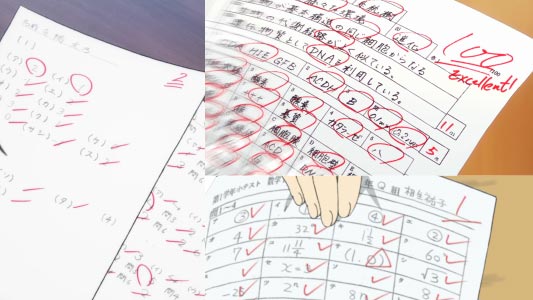

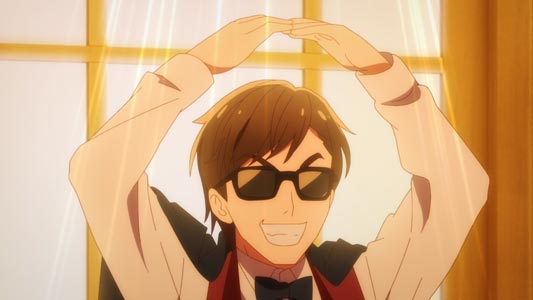
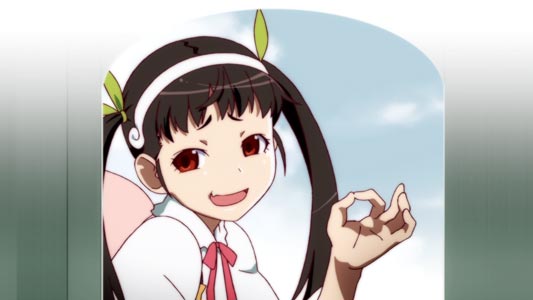
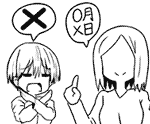
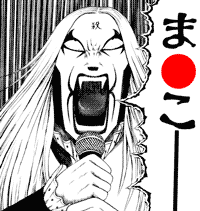

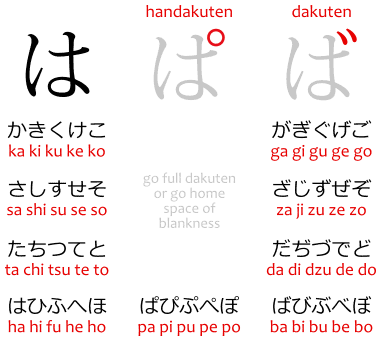

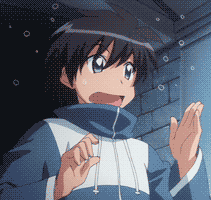
No comments: